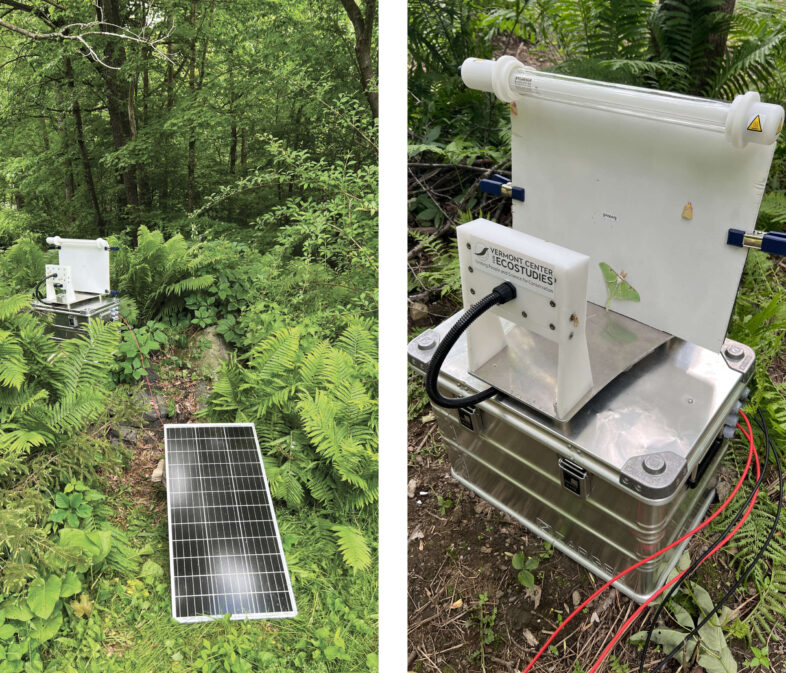
Left: The entire automated moth monitoring set-up; Right: A close-up of the moth monitoring device (notice the Luna Moth still on the screen!) | © Kent McFarland
In The Moth Snowstorm, author Michael McCarthy remembers from his boyhood in the United Kingdom when moths “would pack a car’s headlight beams like snowflakes in a blizzard” and laments that the phenomenon is now just a distant memory. Some are calling it an ‘insect apocalypse.’ Recent reports from around the globe suggest that insect populations are declining at an unprecedented rate. But long-term monitoring projects are few and far between, perhaps even more so here in Vermont.
Vermont is home to over 2,000 moth species, with many more likely to be discovered. Since 1995, over 300 new species have been documented in the Green Mountain State, mostly by community scientists. But moths offer more than just their intriguing diversity and beauty—they also serve important roles as both pollinators and food for other wildlife.
How are moth populations faring in Vermont? Except for a few species, no one really knows. A few years ago, the Vermont Atlas of Life teamed up with community scientists, biologists, engineers, and computer scientists from around the world to change that. Now, we are poised to understand moth phenology, habitat use, and populations like never before.
Combining specialized lighting for attracting moths with high-resolution cameras and a tiny computer, we’ve built an automated moth monitoring device that can provide practical and cost-effective solutions for standardized surveys. In 2022 and 2023, the team deployed the first units in the United Kingdom, European Union, Canada, Cyprus, Panama, Argentina, and, of course, here in Vermont to pilot their use.
At sunset each night, the unit automatically turns on using a solar-powered battery. The computer triggers the camera to snap an image each time a moth lands or moves on the screen. Each image of the screen is analyzed by our computer vision software, first to determine if it is a moth, and if it is, classify it to species. Night after night, the unit monitors all the moths visiting the lights. No biologist needed…well…almost.
Community scientists are key for training the computer vision models. The Vermont Atlas of Life has been promoting moth watching and the sharing of photo observations with our projects at iNaturalist for nearly a decade. There are now over 100,000 images identified to species just from Vermont alone. These photos, combined with tens of thousands of others, helped us train our first computer vision models.
“There’s a tiny computer here which stores the images that the camera takes, and then you can process those photos using an AI algorithm,” said David Rolnick, who grew up chasing insects in Vermont and is now an assistant professor of computer science at Canada CIFAR AI Chair at McGill University and Mila – Quebec, an AI research institute in Montréal that is leading the computer vision work.
Every new computer vision model needs to be verified and tested. Rolnick’s lab came up with a plan. A sample of images from the machines was selected for expert review. Thankfully, JoAnne Russo and Michael Sabourin stepped up to the plate for our region. They painstakingly tested two computer vision algorithms, one that aimed to identify every moth in the image to clip out and another that attempted to identify each moth image to the lowest taxonomic level possible. This tedious but essential work is the only way for us to both test and improve the computer vision models.
Work is underway to add more powerful cameras, new lights, and additional features to the machine, such as sound recording, to broaden the taxonomic groups they can monitor. Soon, these machines will be for more than just moths; they will be biodiversity monitoring units deployed like weather stations today. Perhaps one day, you’ll rise each morning to check the biodiversity report right alongside the weather forecast.

This is amazing work and equipment development! We have sheet-light set ups (less sophisticated and not hooked up to a computer) that we use to monitor the moth diversity in parts of the Hubbard Brook experimental forest in NH. It requires 4am photo sessions with a macro camera. Imagine having an ultrasonic microphone attachment to detect the bats, whom I am sure will notice the congregation of their prey and likely forage.
Thanks Jess. The newer machines actually do have both bat and insect recording devices attached to them. Some of my colleagues have added them near the machines in Europe too. The machines actually are only on every other night and they are also off well before dawn. This helps to discourage them being used as bird and bat feeders. We will be releasing our software later this year, which is an important component to the system as it enables collection of metadata to standards, run AI models, and more.
Wow! What kHz range do you find best for recording to capture the greatest range of signalling insects?
We have not employed sound recording yet, but my colleagues in Europe have. I can ask them and what range the units will be monitoring if that is helpful.
Yes, I would be curious to know! Some of my research is trying to draw connections between bat activity patterns and insect abundance and phenologies across varying habitat types.
Is the model avaliable for UK species?
Yes. UKCEH is a major partner on this project. https://www.ceh.ac.uk/solutions/equipment/automated-monitoring-insects-trap
How terrific! Are the observations from this project entered on INaturalist?
iNaturalist is for human observations. These are machine observations and so they are not on iNaturalist. The amount of data collected is tremendous too, so that would be hard on the iNat system. Once the data is processed, it is shared with the Global Biodiversity Information Facility (GBIF; https://www.gbif.org/) and is available to researchers and others to use. We use it directly in the Vermont Atlas of Life.